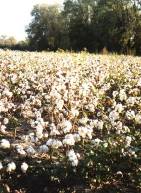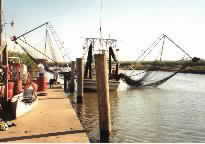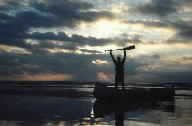Mississippi River Page 4

The Mississippi Queen
Sometimes it wasn’t hard to imagine I was Huck Finn, especially when one of these great old paddlewheel boats passed me. Often people would line the decks and wave. |

Cotton in Arkansas
Below St. Louis, the river tended to be a world apart from the farmlands and towns off the river. Most of the river was lined with levees, from a few feet to a few hundred yards off the river. Usually a strip of hardwood trees and perhaps the levee was visible, but not the countryside beyond. Once, when I stopped to walk into town for groceries at Osceola, Arkansas, I saw these cotton fields. There are hundreds of wingdams along the Mississippi. Most are stone walls running from shore out into the river. They may be sticking out of the water, or they may be completely submerged. They channel the water to increase the current speed so the river will scour the bottom more and stay deeper. |

Memphis |
| A local kayaker took this picture of me as I passed through Memphis. One thing about the river, you get plenty of sun, as it bounces off the water from every direction. |

Towboat Captain |
| One morning this towboat captain waved me over. Born and raised on the river, and from a long line of rivermen, he was interested in everything about the Mississippi. He said the Mississippi was the cleanest river of it’s kind in the world, and as a child his family drank the water untreated. A loaded raft of barges, he said, required great skill and forethought to maneuver down the winding river. Headed downstream, it can take a full mile to stop! |

Natchez, Mississippi |
| Among the many pretty towns along the Mississippi is Natchez. There are only two places where bridges cross the Mississippi on the Mississippi/Louisiana border, here and Vicksburg. |

Ocean-going Ship |
| I had been told many times of the giant wake thrown off by the fast, deep, ocean going ships that traveled as far up as Baton Rouge. “You’ll be swamped for sure,” some folks told me. So it was with some trepidation that I watched as the first big ship raced past, but it turned out I had no problem. Perhaps they slowed down before they reached me, or perhaps it was because I stayed in deeper water where the wave didn’t build so high. |

Camping in the Palmettos |
| After I passed New Orleans, I could smell the salt air. When I camped in the palmettos that night, I couldn’t help but wonder if there were any alligators about. |

Shrimp Boat at South Pass Marina |
| At “Head of Passes,” where the Mississippi splits into several forks, I chose to follow the South Pass. The people at the Marina treated me like an old friend. |

Gulf of Mexico, October 21, 2001 |
| I stayed at a house boat at South Pass the final night on the river. My first night under a roof, but my first night spent on the water (ironic, somehow.) Before dawn I paddled downstream and before long I could hear the ocean waves crashing. The smell of the salt air grew stronger as day broke, and soon the river opened into the Gulf. I paddled out into the ocean swells, and as the waves built decided to head to shore. As I neared the beach the waves grew, and I found myself paddling frantically as I surfed the crest of a big wave up to shore. There, I beached my canoe and took these pictures. I had been on the river for 67 days, and had traveled 2,315 river miles. |
“Twenty years from now you will be more disappointed by the things that you didn’t do than by the ones you did do. So throw off the bowlines. Sail away from the safe harbor. Catch the trade winds in your sails. Explore. Dream. Discover.” H. Jackson Brown Jr
Books about paddling the Mississippi River












Awesome story and pictures. It almost seems like the trip was over before you knew it. Didn’t I hear about you coming into St Augustine FL on that Canoe, weren’t you thinking about canoeing to the bahamas?
Thanks Jonathan,
That must have been someone else. My goal was to paddle to saltwater.
Enjoy your sailing!
Buck
Thanks for the information. It is now mid July 2013. I leave on this journey August one…. I have a 17 foot sea kayak. The Bear Den area is now 1.7. Your pictures and information of the low water are helpful. Nice pictures.
Hi Gregory,
Thanks! You are about to leave on an epic journey. Take lots of photos and keep notes!
Enjoy your adventure,
Buck